| GISdevelopment.net ---> AARS ---> ACRS 2000 ---> SAR/InSAR |
A Study On Differential
Interferometry In Subsidence
C. T. WANG1, H.
T. WANG2, D. C. CHERN3, N. Y. CHEN4, L.
S. LIANG5
1 Assistant Research Scientist, CSRSR, National Central University
2 Professor, CSRSR, National Central University
3 Professor, CSRSR, National Central University
4 Associate Research scientist, CSRSR, National Central University
5 Technician, CSRSR, National Central University
Keywords: Differential Interferometry¢ Subsidence1 Assistant Research Scientist, CSRSR, National Central University
2 Professor, CSRSR, National Central University
3 Professor, CSRSR, National Central University
4 Associate Research scientist, CSRSR, National Central University
5 Technician, CSRSR, National Central University
Abstract
In this study, the technique of differential interferometric synthetic aperture radar (DInSAR)was used to locate the displacement field and to estimate the terrain subsidence of a 45 km x 25 km coastal area, Ton-Kang, southwestern Taiwan. We performed a three-pass differential interferometry from three SAR images from ERS1 and ERS2, dated Jan. 31, 1996, Feb. 1,1996, and May 16, 1996, respectively. The first two images were taken in tandem mode and thus preserving relatively high coherence, from which a DEM was generated with reasonable accuracy except for some mountainous areas. The third image was taken later, and was used to find possible displacement filed during that period through the differential process.
The subsidence of this area has been the subject of an extensive GPS study (Central Geological Survey) from November 1996 to July 1997. Comparison between GPS measurements and DInSAR results are quite favorable both in the pattern of subsidence and in its magnitude (about 2cm/month). We conclude that, given suitable SAR images, the DInSAR technique can be a useful tool for monitoring the earth surface displacement even for a subtropical, densely vegetative area like Taiwan.
1. Introduction
Radar interferometry is a technique for extracting three-dimension information of the Earth's surface by using the phase content of the radar signal as an additional information source derived from the complex radar data. It was first used in observation of the surface of Venus and the Moon. Zebker (Zebker, 1992) and Madsen (Madsen, 1993) presented the practical results of observations with side-looking airborne radar. Zebker (Zebker, 1994) presented accuracy of using ERS1 interferomtry to estimate DEM. Goldsten (Goldsten, 1988) used phase unwrapping to solve the phase discontinuity of the interferogram. Bone (Bone, 1991) made use of mask of local phase discontinuity to unwrap phase. Regarding application of displacement filed, Gabtiel (Gabtiel, 1989) estimated displacement using differential interferometric synthetic aperture radar (DInSAR). Massonnet (Massonnet, 1993) studied earth deformation using differential interferometry due to earthquake. Carnec (Carnec, 1996) gave detail analysis of accuracy of displacement using the DInSAR technique.
There are now many major research groups actively involved in developing SAR interferometric techniques and their applications. In the U.S.A., most of the research is going on at JPL, where Zebker and others (Zebker, 1992/1994) are working on both airborne and satellite SAR interferometry. In Canada, research is mainly carried out by CCRS focusing on airborne systems, and is now also starting on satellite systems since the successful launch of RADARSAT1. In Europe, some of the major research centres specializing in SAR interferometry including Hartl's team at Stuttgart, Germany, Prati and Rocca's research group in Milan, Italy, Vetrella's team at CO.RI.S.T.A., Naples, Italy and groups at the RSL, Zurich, Switzerland, CNES, Toulouse, France, as well as several in the Netherlands such as FEL-TNO, University of Delft, ITC and research groups in several other countries. ESA has set a special interest group on ERS-1 SAR interferometry called ERS-1 FRINGE group.
The main objective of the study is to estimate the ground surface displacement fields using the differential interferometric synthetic aperture radar (DInSAR). The study area is located in the southwestern coast of Taiwan because of dense aquarium there that actively extracts ground water in quite large scale. The estimation by means of DInSAR will be validated by comparing with the GPS ground measurements. In the following section, we describe our data sets, followed by the data processing. We show how to fine-tune the base line based on the interferogram and how to establish a model between differential interferogram and the ground surface displacement field. Section 4 presents some experimental with discussions. Finally, a summary is given to conclude the paper.
2. Data Description
ERS1 and ERS2 are the earth resource satellites and are developed by ESA (European Space Agency). The ERS missions consist of a series of remote sensing satellites to be launched in the 1990s. The first of the series, ERS1, was launched in July 1991. The second of the series, ERS2 was launched in April 1995, in order to ensure the long-term continuity of the data which is essential for many of its operational applications as well as for research purpose. These satellites are devoted entirely to remote sensing from a polar orbit and will make a substantial contribution to the scientific study of our environment. Both of the satellites have the same specifications of SAR instruments. The ERS satellites have Sun-synchronous, near polar, quasi-circular orbits with a mean altitude of 785 km and an inclination of 98.5 degree. For ERS2 a 35-days cycle is currently foreseen coverage the entire mission. Total of the coverage is 501 orbits over the world.
The Satellite Remote Sensing Lab. of CSRSR have acquired and processed the ERS satellites since October 1993. Then in 1996, cooperated with ESA, CSRSR acquired ERS1 and ERS2 Tandem Mode Mission data over most of the south and east of Asia.
The test site of this study is in Southwestern Taiwan, which belongs to ERS1 and ERS2 track 232 and frame 3159(figure 1). To begin, we select the SAR pairs according to the base line information from ESRIN. The base line is best around 100m for our purpose. It turns out that the base line of the first pair is 106 m formed from 31 January 1996 and 1 February 1996. The other pair base line is 2 m from 31 January 1996 and 16 May 1996. The detail parameters regarding these pairs are given in Table 1.
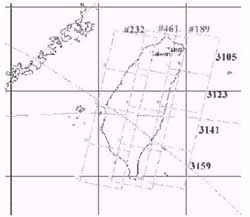
Figure 1 ¢ Coverage map of ERS1/2 over Taiwan
|
|
|
|
|
|
|
|
|
|
|
|
|
|
|
|
|
|
|
|
|
|
|
|
|
|
|
|
|
|
|
|
|
|
|
|
|
|
|
|
|
|
3. Data Processing
The data processing is taken from single look complex image for each scene, and each was identified by a location in latitude and longitude and by date with ground areas of approximately 100 Km x 100 Km with pixel spacing of 7.9 m at slant range and 3.9 m at azimuth. The data are in complex format, with 16-bits representations for each of the real and imaginary parts. One complex scene has 4900 range elements and 26000 azimuth lines with a total size of about 500 MB.
For purpose of demonstration, we performed a three-pass differential interferometry, using three SAR images from ERS1 and ERS2, dated Jan. 31, 1996, Feb. 1, 1996, and May 16, 1996, respectively. The first two images are taken on two consecutive days in tandem mode, thus having relatively high coherence. For urban area the average coherence is about 0.4 and displays clear fringe (Figure2). A DEM was firstly generated from this pair. Fairly good accuracy can be obtained except for high relief areas. The third image was taken much later, 105 days apart, and was used to produce the displacement filed during that period. For urban area the average coherence is about 0.2 with observable fringe pattern. Because the satellites are very close to each other, the base line is only 2 meters (Figure 3).
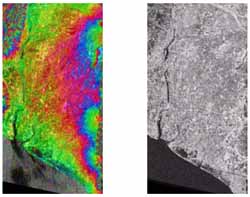
Figure 2 Interferogram and Coherence map of pair 01.31/02.01
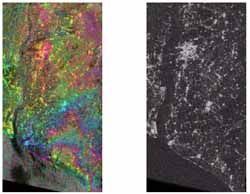
Figure 3 Interferogram and Coherence map of pair 01.31/05.16
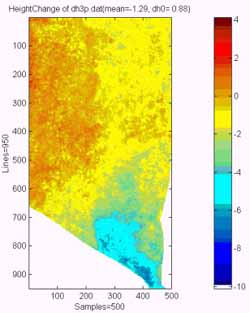 |
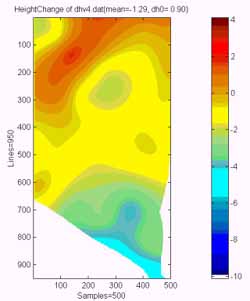 |
|
Differential Interferometry |
|
4. Experimental Results:
In this study, the technique of differential interferometry was used to find the displacement field and to estimate the terrain subsidence of a 45 km x 25 km coastal area, Ton-Kang, southwestern Taiwan. The subsidence of this area has 48 GPS measurement points. The distances of GPSs are from 5 Km to 10 Km. The time difference is about 8 months. Over the test area, southwestern region is subsidence while the northeastern region is arising. For comparison, we interpolated and scaled the GPS data same with time difference of test pairs (Figure 5). It is shown from the comparison that the DInSAR results are consistent with GPS measurements, both in the pattern of subsidence and in its magnitude (about 2cm/month).
5. Summary
- We conclude that, given suitable SAR images, the differential interferometry can be a useful tool for monitoring the earth surface displacement even for a subtropical, densely vegetative area like Taiwan.
- Atmospheric effect should be taken into account in forming the interferogram and subsequent process, because, heavy cloud, for example, can cause the phase shifts resulting appreciable error in displacement estimation.
- For long-term and large area subsidence monitoring, DInSAR provides cost-effective and yet practical tool which is complementary and supplementary to ground GPS surveys.
- RADARSAT has more choices of beam modes which can release limitations of ERS series satellites having high incidence angle causing several layovers over mountain area, and should be considered as another data sources.
This research was partly supported by NSC 88-2612-E-008-003. CSRSR, National Central University supported ERS1 ¢ ERS2 ¢ SPOT images and assistants. Central Geological Survey supported the GPS data of subsidence over test area.
6. References
- Goldsten, R.M., Zebker, H. A., and Werner, C. L.(1988), Satellite radar interferometry: Two-dimensional phase unwrapping, Radio Science, Vol. 23, No. 4, pp. 713-720.
- Gabtiel, A. K., Goldstein, R. M., and Zebker, H. A.(1989), Mapping small elevation changes over large areas: Differential radar Interferometry, j. Geophys. Res., Vol. 94, No. B7, pp. 9183-9191.
- Bone, D. J.(1991), Fourier fringe analysis: the two-dimensional phase unwrapping problem, Applied Optics, Vol. 30, No. 25, pp. 3627-3632.
- Zekber, H. A., and Villasenor, J.(1992), Decorrelation in interferometric radar echoes, IEEE Trans. Geosci. Remote Sensing, Vol.30., No. 5, pp.950-959.
- Madsen, S. N., Zebker, H. A., and Martin, J.(1993), Topographic mapping using radar interferometry: Processing techniques, IEEE Trans. Geosci. Remote Sensing, Vol. 31, No. 1, pp. 246-256.
- Massonnet, D., Rossi, M., Carmona, C., Adragna, F., Peitzer, G., Feigi, K., and Rabaute, T.(1993), The displacement field of the Landers earthquake mapped by radar interferometry, Nature, Vol. 364, No. 8, pp. 138-142.
- Zekber, H. A., Werner, C. L., Rosen, P. A., and Hensley, S.(1994), Accuracy of topographic maps derived from ERS-1 interferometric radar, IEEE Trans. Geosci. Remote Sensing, Vol. 32, No. 4, pp. 823-836.
- Zekber, H. A., Rosen, P. A., Goldstein,R. M., Gabriel,A., and Werner,C. L. (1994), On the derivation of coseismic displacement fields using differential radar interferometry: The Landers earthquake, J, Geophy., Vol. 99, No. B10, pp. 19.617-19.634.
- Carnec. C., Massonnet, D., and King, C.(1996), Two examples of the use of SAR interferometry on displacement fields of small spatial extent, Geophy. Res., Vol. 23, No. 24, pp. 3579-3582.